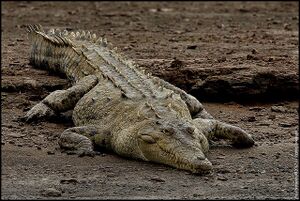Crocodylus ferox
| San Jorgé Crocodile | |
|---|---|

| |
| Crocodylus ferox | |
| Scientific classification | |
| Kingdom: | Animalia
|
| Phylum: | Chordata
|
| Class: | Reptilia
|
| Order: | Crocodilia
|
| Family: | Crocodylidae
|
| Genus: | Crocodylus
|
| Species: | C. ferox
|
| Binomial name | |
| Crocodylus ferox Montez, 1830
| |
Crocodylus ferox, commonly known as the San Jorgé Crocodile, is a large species of crocodilian found in the San Jorgé and Rio Preto basins in Gran Cuscatlan. They are distinguishable by their lighter colored bodies and vertically flattened snouts. This species reached an average of 14ft (4m) in length, with the males being larger than females. The largest recorded specimen, a large male from São Garciha in Paratapais was found to be 18.9ft (5.7m) long.
San Jorgé crocodiles are one of the largest crocodilians in La Ameripacha Libre (LAL), they are remarkably one of the most aggressive. C. ferox has had more recorded attacks on humans per locality than any other species in the genus Crocodylus, and is feared throughout its range for its feisty nature. This species is not a man-eater; however, they are extremely territorial and larger individuals (especially bull males & nesting females) are known to try and fight any other predator or perceived territorial thread.
Prey
Adults are known to prey on smaller caimans and even sometimes Inyurstan Crocodiles in the north-eastern portion of their range. Other prey items include turtles, aquatic lizards such as tegus and "crocodile lizards" and the occasional bird or snake. Juveniles are generalist predators that eat anything they can catch; before transitioning to a mostly reptilian diet as adults.